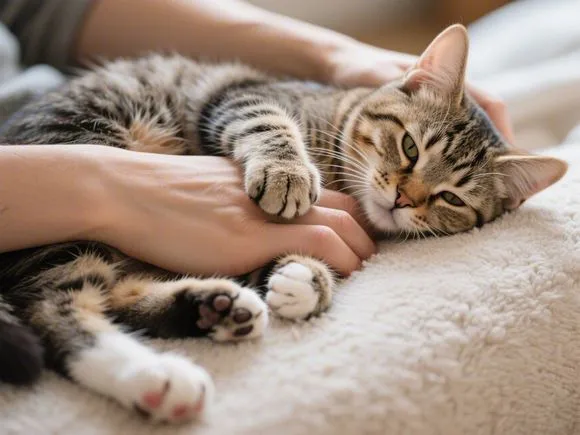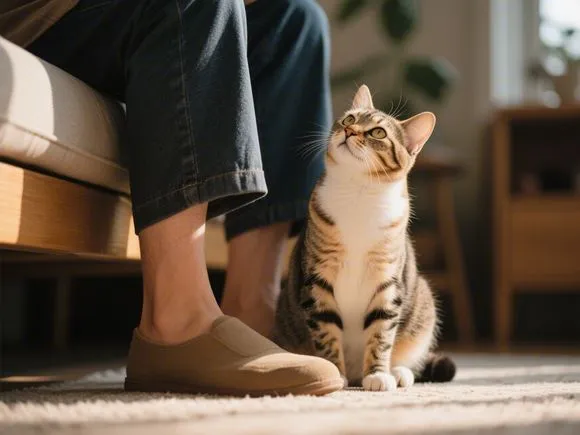

The Science of Feline Attachment
Understanding the deep emotional bond between cats and their owners
Contrary to popular belief, cats form strong emotional attachments to their human companions. Scientific research reveals that approximately 65% of cats exhibit secure attachment to their owners, displaying behaviors and physiological responses that demonstrate genuine affection and dependence.
Key Scientific Findings
Oregon State University Study
In a modified “secure base test” with 108 cats, researchers found distinct attachment styles similar to human-infant bonds, with clear behavioral responses to owner separation and reunion.
Physiological Evidence
Cats show measurable physiological changes when with owners: reduced heart rate, increased oxytocin (“love hormone”) levels, and relaxed body posture indicating comfort and trust.
Voice Recognition
Tokyo University research demonstrated cats can distinguish their owner’s voice from strangers’, showing attentive behaviors like ear movement and vocal response only to familiar voices.
Feline Attachment Styles
Secure Attachment (65%)
These cats use their owner as a secure base for exploration. They show distress when separated but quickly seek comfort and return to normal activity upon reunion.
- Actively greets owner with head rubs and purring
- Confidently explores when owner is present
- Seeks physical contact for reassurance
Ambivalent Attachment (20%)
These cats show intense distress during separation but display conflicting behaviors upon reunion – both seeking and resisting contact simultaneously.
- Extreme vocalization and agitation when left alone
- Approaches then withdraws from returning owner
- May show brief aggression after reunion
Avoidant Attachment (15%)
These cats appear indifferent to their owner’s presence or absence, showing minimal greeting behaviors and actively avoiding interaction.
- Little visible distress during separation
- Ignores or avoids returning owner
- Prefers solitary activities even when owner is available
Signs Your Cat is Attached to You
1 Physical Affection
- Head-butting or rubbing against you (scent marking)
- Kneading with paws while purring
- Sleeping on or near you regularly
- Showing belly (ultimate sign of trust)
2 Social Behaviors
- Following you from room to room
- Greeting you at the door
- Slow blinking (cat “kisses”)
- Bringing you “gifts” (toys or prey)
3 Vocal Communication
- Purring when near you (contentment)
- Trilling or chirping greetings
- Meowing specifically for your attention
- Conversational meows (responding to your voice)
4 Physiological Signs
- Lowered heart rate when petted
- Increased oxytocin levels during interaction
- Deep, relaxed sleep in your presence
- Pupil dilation when happy to see you
Factors Influencing Attachment Strength
Cat Characteristics
Breed Tendencies
- Maine Coon: Highly affectionate, follows owners
- Siamese: Demands constant interaction
- Ragdoll: Relaxed and trusting
- British Shorthair: More independent
Age Differences
- Kittens (2-3 months): Form strongest bonds during socialization period
- Adults: More independent but still affectionate
Owner Behaviors
Quality Interaction
- 30+ minutes daily interactive play
- Gentle petting in preferred areas
- Positive vocal interactions
Care Routines
- Consistent feeding schedule
- Reward-based training
- Clean living environment
Environmental Factors
Living Space
- Adequate space for exercise and climbing
- Comfortable resting areas near human activity
- Hiding spots for security
Social Environment
- Harmonious multi-pet households
- Consistent human presence
- Minimal loud noises or stressors
How Cat Attachment Benefits Humans
Psychological Benefits
- Stress Reduction: Petting cats lowers cortisol by 30-40%
- Anxiety Relief: Purring vibrations (20-140Hz) have calming effects
- Depression Alleviation: Companionship reduces loneliness
- Self-Esteem: Caring for another being boosts confidence
Physical Health Benefits
- Cardiovascular: 30% lower heart attack risk for cat owners
- Immunity: Children with cats have fewer allergies
- Sleep Quality: 41% sleep better with cats in bed
- Pain Management: Purring may aid bone healing
Social Benefits
- Community: 68% meet neighbors through pets
- Online Networks: Cat content drives social connections
- Elderly Care: 82% of seniors report better quality of life
- Child Development: Teaches responsibility and empathy
Lifestyle Improvements
- Routine: Feeding schedules create structure
- Activity: Play sessions increase movement
- Mindfulness: Observing cats promotes present-moment awareness
- Creativity: Many writers/artists draw inspiration from cats
Strengthening Your Bond
Understanding Feline Communication
- Slow blinking: The “cat kiss” – return the gesture to show trust
- Tail position: Straight up = happy; puffed = scared; low = insecure
- Ear signals: Forward = curious; sideways = uneasy; back = angry
- Vocalizations: Short meows = greeting; long meows = demands
Creating a Cat-Friendly Environment
- Vertical space: Cat trees/shelves satisfy climbing instincts
- Safe zones: Provide hiding spots for stress relief
- Scratching posts: Essential for marking territory and claw health
- Window access: Bird watching provides mental stimulation
Bonding Through Play
- Interactive toys: Wand toys mimic prey movement (10-15 min sessions)
- Puzzle feeders: Stimulate natural hunting behaviors
- Training sessions: Teach tricks using clicker training (3-5 min)
- Novelty: Rotate toys weekly to maintain interest
Positive Reinforcement Techniques
- Treat timing: Reward within 3 seconds of desired behavior
- Respect boundaries: Never force interaction – let cat initiate
- Grooming: Gentle brushing mimics social bonding
- Scent exchange: Rub a soft cloth on your cat then on yourself
Cats & Humans: A 10,000 Year Journey
~10,000 BCE
Wild cats began associating with early agricultural settlements in the Fertile Crescent, drawn by rodent populations attracted to grain stores. This marked the beginning of commensal relationship.
~7,500 BCE
Earliest archaeological evidence of cat domestication from Cyprus, where a cat was deliberately buried with a human, suggesting special status.
~3,000 BCE
Cats became sacred in ancient Egypt, associated with the goddess Bastet. Killing a cat was punishable by death, and cats were mummified for the afterlife.
500 BCE – 400 CE
Spread through Greek and Roman civilizations as pest controllers and companions. Romans introduced cats throughout their empire.
Middle Ages
European cats persecuted due to associations with witchcraft. This contributed to rat populations and possibly exacerbated the Black Death.
18th-19th Century
Cats regained popularity during Enlightenment. Victorian era saw the beginning of cat fancy and selective breeding.
20th-21st Century
Transition from working animals to companion pets. Modern research confirms emotional bonds between cats and owners. Internet culture elevates cats to global celebrity status.
Key Takeaways
The bond between cats and humans is both ancient and profound, supported by growing scientific evidence of emotional attachment that benefits both species.
Scientific Consensus
- 65% of cats form secure attachments to owners
- Attachment styles mirror human infant-caregiver bonds
- Physiological changes confirm emotional connection
Practical Implications
- Quality interaction strengthens bonds more than quantity
- Understanding feline communication prevents misunderstandings
- Environmental enrichment benefits both cat and owner wellbeing
Mutual Benefits
- Cats provide stress relief, companionship, and health benefits
- Humans offer security, resources, and social interaction
- This symbiotic relationship has evolved over millennia
Future Directions
- Need for more diverse and naturalistic studies
- Exploring neurological basis of interspecies bonding
- Applications for animal-assisted therapy and welfare